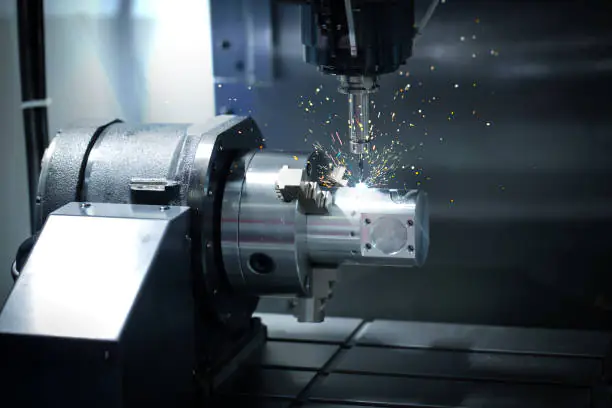AutoCAD is one of the most versatile and widely used software tools for computer-aided design (CAD), and it plays an essential role in the world of CNC machining. If you’ve ever wondered how to take a design from AutoCAD and turn it into a workable CNC program, this article will guide you step by step. Whether you’re new to CNC programming or looking to refine your skills, this guide will help you create CNC-ready files directly from your AutoCAD designs, making the journey to CNC machine operation straightforward and accessible.
Understanding the Role of AutoCAD in CNC Machining
What is AutoCAD?
AutoCAD is a powerful CAD tool used for creating precise 2D and 3D drawings that are the starting point for many CNC machining processes. The software provides the capability to generate detailed designs, which can then be converted into machine-readable code, such as G-code.
- CAD to CNC: The key advantage of AutoCAD is its ability to take complex designs and translate them into a digital format that can be processed by CAM software and subsequently by CNC machines.
- Precision and Flexibility: It allows for precise measurements and annotations, ensuring that your CNC machine receives exact instructions for every part of the workpiece.
For more details on how spindles work in CNC machines, check out our CNC Spindle Motors page. This page provides an in-depth look at how spindle motors impact CNC operations.
Importance of AutoCAD in CNC Machining
The value of AutoCAD in the CNC machining workflow is significant. The detailed designs created in AutoCAD are the foundation of successful CNC operations. The CAD file is first designed, then converted to G-code that controls the CNC machine’s movements and cutting actions.
- Precision Design: AutoCAD allows for the creation of highly detailed parts, including intricate geometries and tight tolerances that CNC machines can replicate accurately.
- Versatility: From designing metal parts to 3D prototypes, AutoCAD can handle a range of applications, providing a perfect foundation for CNC programs.
Steps to Create a CNC Program in AutoCAD
Step 1: Designing the Part
The first step in making a CNC program in AutoCAD is to design the part that you want to manufacture. This involves creating a detailed drawing with all the necessary dimensions and annotations.
Setting Up the Workspace
Before starting the design, you need to set up your workspace properly. This includes defining units, scale, and drawing limits.
- Units and Scale: Determine the appropriate units (inches or millimeters) and scale that will fit the machine’s capabilities.
- Layers and Linetypes: Utilize different layers and linetypes to distinguish between cut lines, engrave lines, and boundary lines. Layers help in organizing your drawing and make it easier to convert elements into G-code.
Drawing Techniques in AutoCAD
AutoCAD provides a variety of tools that help in drawing precise and accurate designs:
- Line Tool: Use the line command for straight edges.
- Circle and Arc Tools: These are useful for creating round features or curved paths in the design.
- Dimension Tool: Adding dimensions ensures that each feature has the right measurement, which is crucial for CNC accuracy.
To optimize your CNC spindle’s effectiveness during the machining, visit our 24000RPM 3.2KW ER20 Water-Cooled Spindle page to understand the best spindle options for such detailed work.
Step 2: Exporting the Design
Once your part is designed, you need to export it in a format compatible with CAM (Computer-Aided Manufacturing) software. CAM software is responsible for converting the CAD file into G-code for CNC machining.
File Formats for Export
AutoCAD files must be exported in formats that are compatible with CNC machines. Some of the common file types include:
- DXF (Drawing Exchange Format): DXF files are widely used for CNC as they preserve the geometry created in AutoCAD.
- DWG: The native format of AutoCAD, which can be imported into many CAM software.
Steps for Exporting
- Save As: Choose “Save As” from the File menu, and select DXF or DWG as the file format.
- Check Geometry: Make sure that all lines are properly closed and connected. Open ends can lead to errors during CNC machining.
Step 3: Converting CAD to G-code with CAM Software
Once you have your design in the appropriate format, the next step is to convert it into G-code. G-code is the language used to command CNC machines on how to move, cut, and shape the material.
Importing the File into CAM Software
Choose a suitable CAM software such as Fusion 360 or MasterCAM. Import your DXF or DWG file into the CAM program.
- Verify the Import: Make sure all features of the design have been properly imported.
- Assign Machining Operations: Use the CAM software to assign machining operations like drilling, pocketing, or profiling based on the design features.
Generating the G-code
After setting up the machining operations, you can generate the G-code:
- Post-Processor Selection: Choose a post-processor compatible with your CNC machine. Different machines have different G-code requirements.
- Simulation: Run a simulation to ensure the tool path is correct and that there will be no collisions or errors during the cutting process.
Step 4: Setting Up the CNC Machine
Once you have your G-code file, it’s time to set up the CNC machine.
Loading the G-code
Transfer the G-code file to the CNC machine using a USB drive or network connection.
- Verify Coordinates: Always verify that the coordinates match the intended dimensions from the AutoCAD drawing.
- Machine Settings: Adjust the machine settings such as feed rate, spindle speed, and tool offsets to match the requirements of your specific job.
Securing the Workpiece
The workpiece must be clamped properly to avoid movement during the cutting process. Any misalignment can result in inaccuracies and material waste.
- Clamps or Vices: Use appropriate clamps or a vice to secure the workpiece firmly onto the machine bed.
- Workpiece Alignment: Align the workpiece with the machine’s X, Y, and Z axes before starting the operation.
Tools and Techniques for CNC Programming in AutoCAD
Tool Path Strategies
Different tool path strategies can optimize how a CNC machine processes a workpiece.
Contour Milling vs. Pocketing
- Contour Milling: This is used to cut around the outer edges of a part. It follows the boundary lines created in AutoCAD.
- Pocketing: This involves removing large sections of material from within a boundary, useful for creating depressions or slots.
Selecting the Right Cutting Tools
Using the appropriate cutting tool is essential for achieving the desired finish.
- End Mills: Used for general-purpose milling.
- Ball Nose Cutters: Ideal for creating rounded surfaces.
- V-Bits: These are used for engraving or detailed work.
To learn more about the best spindle to use for different cutting tools, visit our 2.2KW ER20 Square Air-Cooled Spindle with Flange.
Common Mistakes and How to Avoid Them
Open Geometry in CAD File
An open geometry means there are gaps between lines that should be connected. These can cause significant problems when generating the G-code.
- Tip: Always use the JOIN command in AutoCAD to connect line segments before exporting the file.
Incorrect Tool Path Selection
Choosing the wrong tool path can lead to inefficient machining or poor-quality finishes.
- Solution: Utilize CAM software simulations to preview the machining operations and make adjustments where necessary.
Improper Material Settings
Incorrect settings for spindle speed, feed rate, or depth of cut can lead to tool wear or material damage.
- Tip: Always consult material guidelines to select the appropriate settings.
Frequently Asked Questions
1. Can I use AutoCAD for CNC programming?
Yes, AutoCAD is highly effective for creating 2D and 3D designs that can be exported to CAM software, where G-code is generated for CNC machines.
2. What file format should I use to export my AutoCAD design for CNC machining?
The DXF format is most commonly used for CNC applications because it retains all the necessary geometry.
3. Is G-code hard to learn?
Learning G-code can be challenging at first, but with practice and an understanding of basic commands, it becomes much easier to grasp.
4. Can I use the same AutoCAD file for different CNC machines?
Yes, as long as the file is compatible with the CAM software that generates machine-specific G-code. The post-processor plays an important role here.
5. What’s the importance of tool path optimization?
Tool path optimization helps in reducing machining time, improving surface finish, and extending tool life.
Conclusion
Creating a CNC program from an AutoCAD design might seem complex at first, but once you understand the basic workflow—from design to G-code—it becomes a smooth and rewarding process. By mastering tools like AutoCAD and integrating them effectively with CAM software, you can unlock the full potential of CNC machining. This not only improves efficiency but also enhances the precision of your finished products. If you’re looking for the best CNC spindles to optimize your machine’s performance, check out our CNC Spindle Options. Learning to program a CNC machine using AutoCAD is more than just a technical skill—it’s an art that combines creativity with engineering precision.

